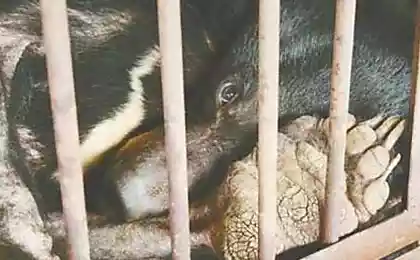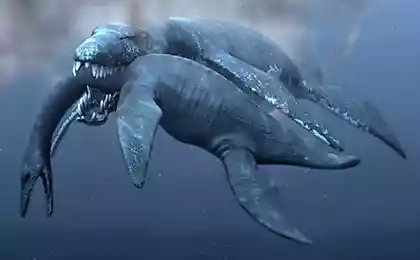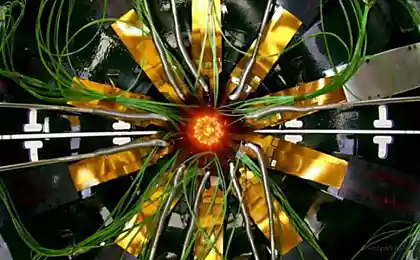3524
Strange animals
Bald uakari (Bald Uakari)
Bald uakari are one of the species of monkeys, endemic in Brazil and Peru, which are known for their bright red face. A flock of these monkeys called detachment, and they prefer to live in high trees, away from the constant floods that afflict their habitat. Scientists believe that the colorful monkey face is the result of a lack of pigment on their heads, allowing the red color of the blood vessels be seen through the skin. This is actually a disadvantage for survival monkeys because predators can easily see it, but that person is also a sign of a healthy immune system.
Unfortunately for these monkeys living in the jungle, they are slowly moving towards extinction, largely due to the fact that people hunt them. Bald uakari more pale faces, are known to be removed from malaria and other uakari, deciding not to participate in reproduction.
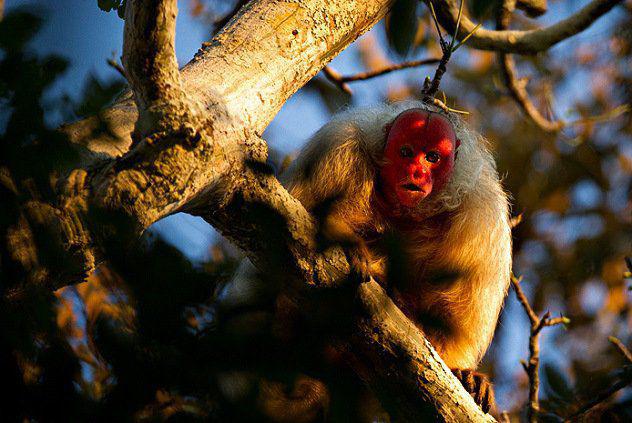
Weevil-giraffe (Giraffe Weevil)
Giraffe weevil, which got its name because of its abnormally long neck, is a species of beetles that live on the island of Madagascar. Despite the fact that the presence of so long neck may seem very uncomfortable, this strange anomaly is critical in the life of a beetle. For males their necks provide a means of combating other males, usually for a female weevil. Neck male weevils twice longer than that of females weevils.
Madagascar weevils represent trees that are intended for weevils and only for weevils. They use these special trees as a food source, as well as a comfortable living environment. Their soft and delicate wings tucked in a protective sheath called elytra.
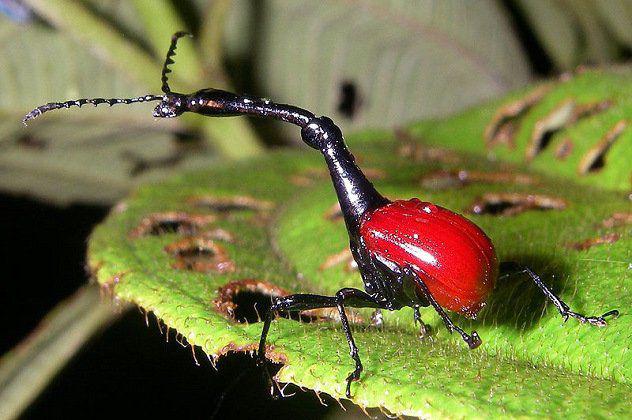
Snub-nosed monkey (Snub-Nosed Monkey)
Snub-nosed monkey more like Michael Jackson after surgery than primates. They were only discovered recently in the Asian country of Myanmar, after a few individuals have been accidentally shot by hunters. Since then, scientists have been monitoring these monkeys in the jungle during the rainy season. Scientists thought this would be a good time to observe their unusual behavior, which includes the folding head in a ball to protect themselves from the water because of their odd shape of the nose allows water to easily enter the nostrils, causing them to sneeze constantly.
Number Snub-nosed monkey in Myanmar currently keeps around 260-300 individuals, but it could at any time be reduced because of their tasty meat, which is appreciated by hunters. Fortunately, they eat berries and live on the high tops of trees, so it is difficult for hunters to catch them.
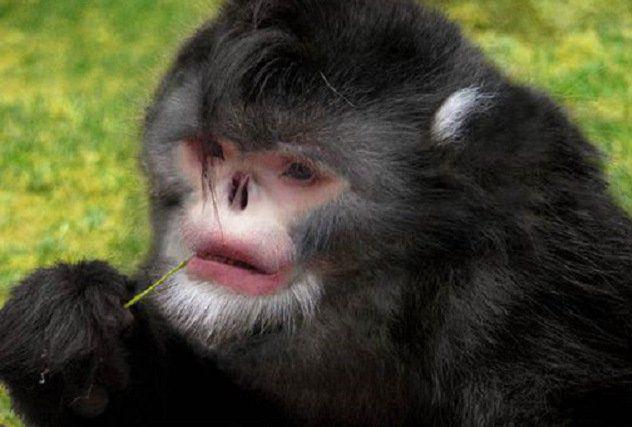
Icefish (Ice Fish)
Ice fish, first discovered Detlef Rustad (Ditlef Rustad) in 1927, is a peculiar-looking body, and lives off the coast of Antarctica. It has impressive features of the body, including the teeth and ghostly white body. This appearance, which resembles a phantom, is the result of lack of hemoglobin in her blood, which makes the fish as transparent as a window.
The mystery of how these fish exist without hemoglobin, which is an important substance that carries oxygen through the blood, has puzzled researchers for over 60 years. Recently, scientists have speculated that the ice fish can absorb oxygen through the skin and not through the gills and blood. Another possibility is that instead of using a blood oxygen transport, they use blood plasma, the liquid component of blood, which represents 55 per cent of the total volume of blood and cause coagulation. Blood plasma yellowish color may be the reason that the insides of the fish have a yellowish tinge.
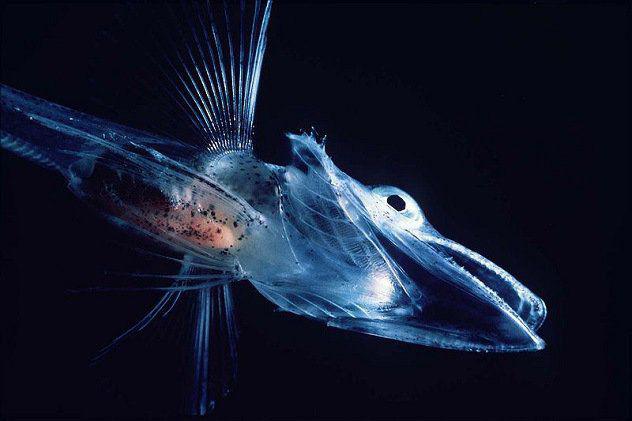
Largemouth (Gulper Eel)
Extremely rare largemouth sometimes also called acne-pelican. These creatures live deep in the ocean. One of the reasons why they are so rare, is that the females lay eggs in the deep waters so that the offspring often do not survive after hatching.
Largemouth pushes his jaw incredibly big mouth to swallow no less enormous booty which he lures brilliant bioluminescent balls on the end of his tail. Extraction is then digested in gastric motility which stretches to accommodate lunch eel. As soon as largemouth gets older, his teeth are gradually disappearing, but his sense of smell is greatly improved, to compensate for the lack of teeth.

Hummingbird hawk-moth (Hummingbird Hawk-Moth)
Hummingbird hawk-moth inhabits almost the entire southern part of Europe and Asia, is a moth that looks like a hummingbird. It not only has a proboscis as Hummingbird or butterfly its proboscis even split into two tubes when they need to be cleaned. Sac in front of the head is filled with air, when a moth breathes, and then deflates when he breathes, allowing him to suck nectar.
Along with having the proboscis like a hummingbird, its wings can move so quickly, uttering the same low humming noise during flight. These moths also have a great memory, they repeatedly returned to the same 50 flowers.
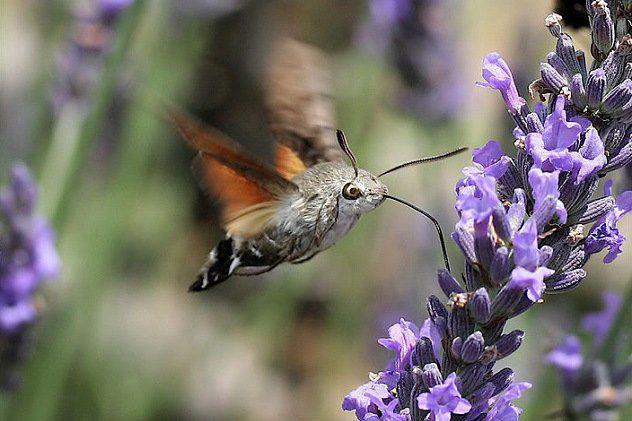
Flying frog (Flying Frog)
Flying Frog is a rare species, which descends from his tree only to mate. Also known as Rhacophoridae view has strong membrane between the toes of the front and hind legs. Scientists initially thought that these webbed fingers used for swimming because it is a common thing for frogs, so they were surprised to see how frogs instead planned from tree to tree to avoid predators.
The greatest distance that flying frog was able to overcome in one leap, is more than 15 meters. This distance is just enough to move to another tree or even on the ground. Besides webbed toes on their front paws, these amphibians have large soft yellow-green fingers on his hind legs, which help them attach to the trees for a safe landing, as well as that of geckos.
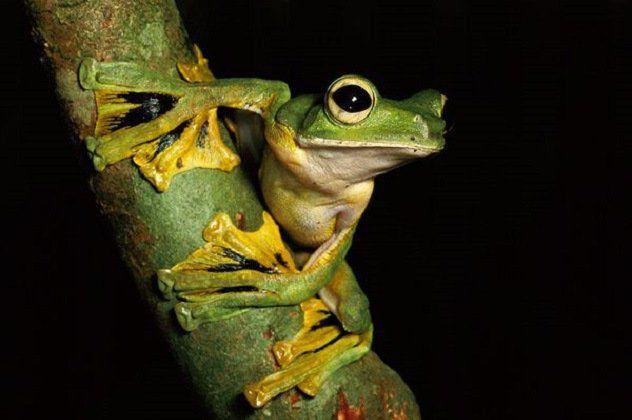
Salps (Salpa)
Perhaps this is one of the strangest creatures in the world. At the sight of salps can swear that this animal from another planet. Surprisingly, this being similar to jellyfish and dwelt off the coast of California, it is not a jellyfish. In fact, it consists of smaller organisms that are held and work together. Each salpa, as they are called individually consists of plankton and virtually harmless.
These organisms is becoming more and more in recent years due to their incredible ability to clone himself at will. However, these peaceful creatures cause more problems than you think. They destroyed two fishing nets after caught in them and even caused the shutdown nuclear power plants in California. Scientists say that their ability to adapt to different water temperature and immunity to contamination caused by man, meaning that they may soon fill the ocean.
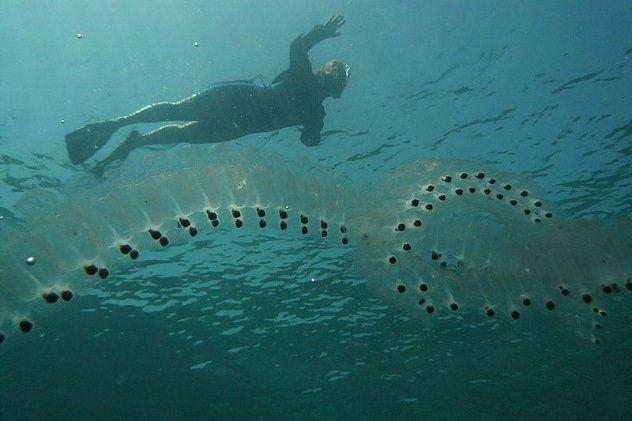
Indian purple frog (Indian Purple Frog)
Indian Purple frog, apparently, was not enough to have color, which no longer has any other amphibian, she has also developed an incredible muzzle and small plump body. When these strange frogs are born, they begin life as tadpoles, frogs as ordinary water. The difference is that these tadpoles have the same distinctive pig nose that hangs from a hook of their faces.
Scientists believe that these strange features of their appearance evolved due to the fact that they live their entire lives underground. Their short legs designed for digging under the ground like tiny shovels. They do everything under the earth, and come to the surface only for two weeks in my entire life. During these two weeks, frogs only have enough time to find a mate and reproduce before leaving back into the earth, never to appear on the surface. During this time, the males sing loudly to attract females, and the sound of their serenades becoming louder as the gain of rain.

Carpet (hovering) octopus (Blanket Octopus)
Carpet (hovering) Octopus (also known as purple tremoktopus) living in the seas of New Zealand and Australia, is as rare a creature as largemouth, but lives in a much more shallow waters. Distinguish males from females of this species is easy, because the female is almost 2 meters longer than the males. Their "blanket" is used to capture prey, but if for some reason the octopus can not lure the fish his blanket, he can detach part of it, to make themselves more "attractive».
But in the world of octopus is not so good. Archenemy carpet octopus is Portuguese ship, highly toxic jellyfish. Octopus is not susceptible to toxins jellyfish, but when the female octopus entangled in the tangle of these gelatinous masses, they literally tear off some of its own tentacles and use them as weapons. Males have a tentacle, designed specifically for reproduction, which disappears as soon as the pairing is completed, resulting in the male dies.
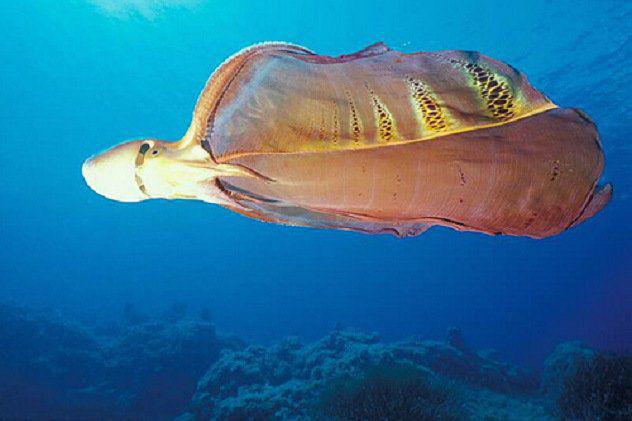
Source: www.fresher.ru
Bald uakari are one of the species of monkeys, endemic in Brazil and Peru, which are known for their bright red face. A flock of these monkeys called detachment, and they prefer to live in high trees, away from the constant floods that afflict their habitat. Scientists believe that the colorful monkey face is the result of a lack of pigment on their heads, allowing the red color of the blood vessels be seen through the skin. This is actually a disadvantage for survival monkeys because predators can easily see it, but that person is also a sign of a healthy immune system.
Unfortunately for these monkeys living in the jungle, they are slowly moving towards extinction, largely due to the fact that people hunt them. Bald uakari more pale faces, are known to be removed from malaria and other uakari, deciding not to participate in reproduction.

Weevil-giraffe (Giraffe Weevil)
Giraffe weevil, which got its name because of its abnormally long neck, is a species of beetles that live on the island of Madagascar. Despite the fact that the presence of so long neck may seem very uncomfortable, this strange anomaly is critical in the life of a beetle. For males their necks provide a means of combating other males, usually for a female weevil. Neck male weevils twice longer than that of females weevils.
Madagascar weevils represent trees that are intended for weevils and only for weevils. They use these special trees as a food source, as well as a comfortable living environment. Their soft and delicate wings tucked in a protective sheath called elytra.

Snub-nosed monkey (Snub-Nosed Monkey)
Snub-nosed monkey more like Michael Jackson after surgery than primates. They were only discovered recently in the Asian country of Myanmar, after a few individuals have been accidentally shot by hunters. Since then, scientists have been monitoring these monkeys in the jungle during the rainy season. Scientists thought this would be a good time to observe their unusual behavior, which includes the folding head in a ball to protect themselves from the water because of their odd shape of the nose allows water to easily enter the nostrils, causing them to sneeze constantly.
Number Snub-nosed monkey in Myanmar currently keeps around 260-300 individuals, but it could at any time be reduced because of their tasty meat, which is appreciated by hunters. Fortunately, they eat berries and live on the high tops of trees, so it is difficult for hunters to catch them.

Icefish (Ice Fish)
Ice fish, first discovered Detlef Rustad (Ditlef Rustad) in 1927, is a peculiar-looking body, and lives off the coast of Antarctica. It has impressive features of the body, including the teeth and ghostly white body. This appearance, which resembles a phantom, is the result of lack of hemoglobin in her blood, which makes the fish as transparent as a window.
The mystery of how these fish exist without hemoglobin, which is an important substance that carries oxygen through the blood, has puzzled researchers for over 60 years. Recently, scientists have speculated that the ice fish can absorb oxygen through the skin and not through the gills and blood. Another possibility is that instead of using a blood oxygen transport, they use blood plasma, the liquid component of blood, which represents 55 per cent of the total volume of blood and cause coagulation. Blood plasma yellowish color may be the reason that the insides of the fish have a yellowish tinge.

Largemouth (Gulper Eel)
Extremely rare largemouth sometimes also called acne-pelican. These creatures live deep in the ocean. One of the reasons why they are so rare, is that the females lay eggs in the deep waters so that the offspring often do not survive after hatching.
Largemouth pushes his jaw incredibly big mouth to swallow no less enormous booty which he lures brilliant bioluminescent balls on the end of his tail. Extraction is then digested in gastric motility which stretches to accommodate lunch eel. As soon as largemouth gets older, his teeth are gradually disappearing, but his sense of smell is greatly improved, to compensate for the lack of teeth.

Hummingbird hawk-moth (Hummingbird Hawk-Moth)
Hummingbird hawk-moth inhabits almost the entire southern part of Europe and Asia, is a moth that looks like a hummingbird. It not only has a proboscis as Hummingbird or butterfly its proboscis even split into two tubes when they need to be cleaned. Sac in front of the head is filled with air, when a moth breathes, and then deflates when he breathes, allowing him to suck nectar.
Along with having the proboscis like a hummingbird, its wings can move so quickly, uttering the same low humming noise during flight. These moths also have a great memory, they repeatedly returned to the same 50 flowers.

Flying frog (Flying Frog)
Flying Frog is a rare species, which descends from his tree only to mate. Also known as Rhacophoridae view has strong membrane between the toes of the front and hind legs. Scientists initially thought that these webbed fingers used for swimming because it is a common thing for frogs, so they were surprised to see how frogs instead planned from tree to tree to avoid predators.
The greatest distance that flying frog was able to overcome in one leap, is more than 15 meters. This distance is just enough to move to another tree or even on the ground. Besides webbed toes on their front paws, these amphibians have large soft yellow-green fingers on his hind legs, which help them attach to the trees for a safe landing, as well as that of geckos.

Salps (Salpa)
Perhaps this is one of the strangest creatures in the world. At the sight of salps can swear that this animal from another planet. Surprisingly, this being similar to jellyfish and dwelt off the coast of California, it is not a jellyfish. In fact, it consists of smaller organisms that are held and work together. Each salpa, as they are called individually consists of plankton and virtually harmless.
These organisms is becoming more and more in recent years due to their incredible ability to clone himself at will. However, these peaceful creatures cause more problems than you think. They destroyed two fishing nets after caught in them and even caused the shutdown nuclear power plants in California. Scientists say that their ability to adapt to different water temperature and immunity to contamination caused by man, meaning that they may soon fill the ocean.

Indian purple frog (Indian Purple Frog)
Indian Purple frog, apparently, was not enough to have color, which no longer has any other amphibian, she has also developed an incredible muzzle and small plump body. When these strange frogs are born, they begin life as tadpoles, frogs as ordinary water. The difference is that these tadpoles have the same distinctive pig nose that hangs from a hook of their faces.
Scientists believe that these strange features of their appearance evolved due to the fact that they live their entire lives underground. Their short legs designed for digging under the ground like tiny shovels. They do everything under the earth, and come to the surface only for two weeks in my entire life. During these two weeks, frogs only have enough time to find a mate and reproduce before leaving back into the earth, never to appear on the surface. During this time, the males sing loudly to attract females, and the sound of their serenades becoming louder as the gain of rain.

Carpet (hovering) octopus (Blanket Octopus)
Carpet (hovering) Octopus (also known as purple tremoktopus) living in the seas of New Zealand and Australia, is as rare a creature as largemouth, but lives in a much more shallow waters. Distinguish males from females of this species is easy, because the female is almost 2 meters longer than the males. Their "blanket" is used to capture prey, but if for some reason the octopus can not lure the fish his blanket, he can detach part of it, to make themselves more "attractive».
But in the world of octopus is not so good. Archenemy carpet octopus is Portuguese ship, highly toxic jellyfish. Octopus is not susceptible to toxins jellyfish, but when the female octopus entangled in the tangle of these gelatinous masses, they literally tear off some of its own tentacles and use them as weapons. Males have a tentacle, designed specifically for reproduction, which disappears as soon as the pairing is completed, resulting in the male dies.

Source: www.fresher.ru






